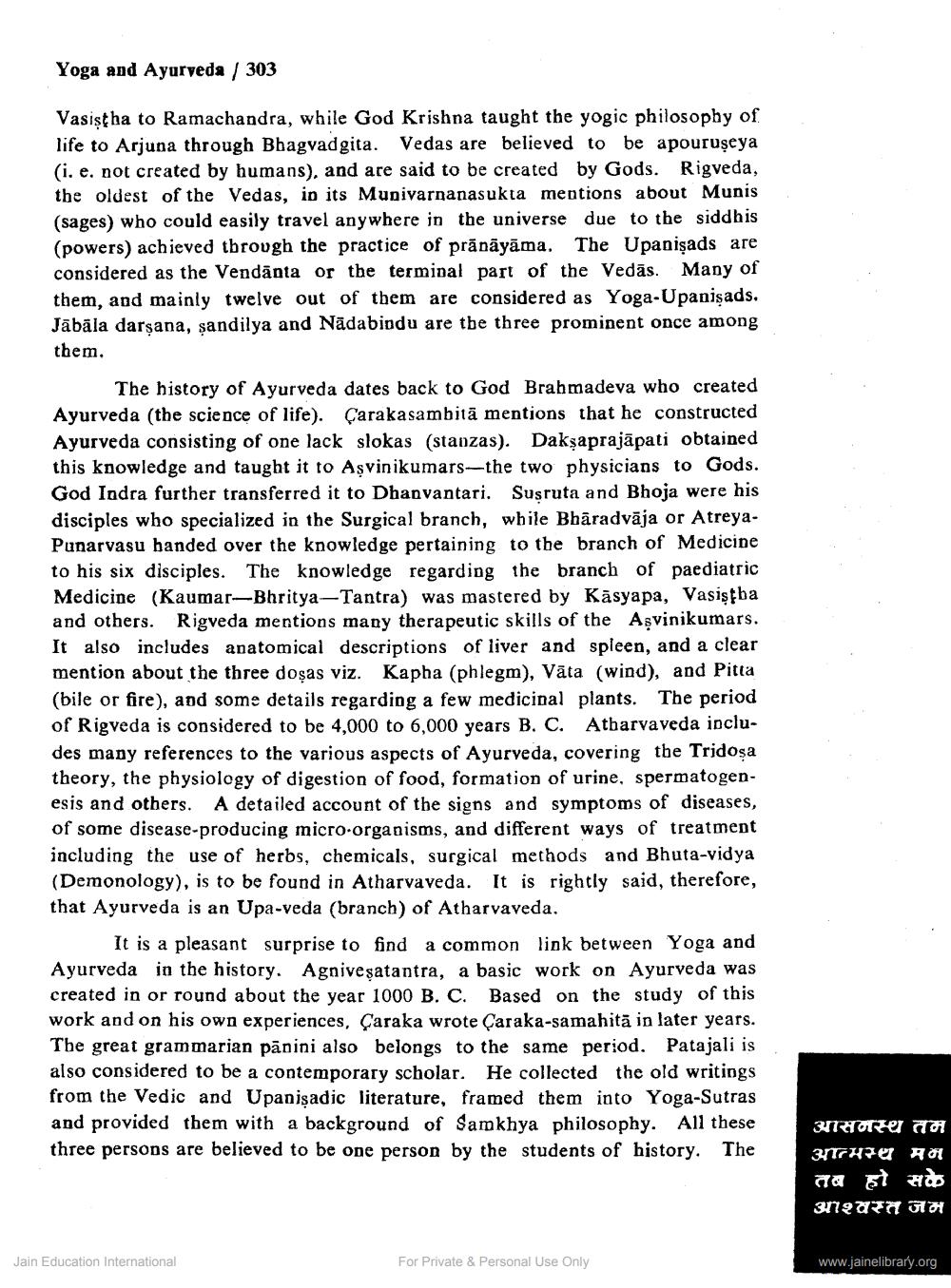________________
Yoga and Ayurveda / 303
Vasistha to Ramachandra, while God Krishna taught the yogic philosophy of life to Arjuna through Bhagvadgita. Vedas are believed to be apouruşeya (i. e. not created by humans), and are said to be created by Gods. Rigveda, the oldest of the Vedas, in its Munivarnanasukta mentions about Munis (sages) who could easily travel anywhere in the universe due to the siddhis (powers) achieved through the practice of pränäyäma. The Upanisads are considered as the Vendanta or the terminal part of the Vedas. Many of them, and mainly twelve out of them are considered as Yoga-Upanisads. Jābāla darṣana, şandilya and Nadabindu are the three prominent once among them.
The history of Ayurveda dates back to God Brahmadeva who created. Ayurveda (the science of life). Carakasambitä mentions that he constructed Ayurveda consisting of one lack slokas (stanzas). Dakṣaprajapati obtained this knowledge and taught it to Aşvinikumars-the two physicians to Gods. God Indra further transferred it to Dhanvantari. Susruta and Bhoja were his disciples who specialized in the Surgical branch, while Bharadvaja or AtreyaPunarvasu handed over the knowledge pertaining to the branch of Medicine to his six disciples. The knowledge regarding the branch of paediatric Medicine (Kaumar-Bhritya-Tantra) was mastered by Käsyapa, Vasistha and others. Rigveda mentions many therapeutic skills of the Agvinikumars. It also includes anatomical descriptions of liver and spleen, and a clear mention about the three dosas viz. Kapha (phlegm), Vata (wind), and Pitta (bile or fire), and some details regarding a few medicinal plants. The period of Rigveda is considered to be 4,000 to 6,000 years B. C. Atharvaveda includes many references to the various aspects of Ayurveda, covering the Tridoșa theory, the physiology of digestion of food, formation of urine, spermatogenesis and others. A detailed account of the signs and symptoms of diseases, of some disease-producing micro-organisms, and different ways of treatment including the use of herbs, chemicals, surgical methods and Bhuta-vidya (Demonology), is to be found in Atharvaveda. It is rightly said, therefore, that Ayurveda is an Upa-veda (branch) of Atharvaveda.
It is a pleasant surprise to find a common link between Yoga and Ayurveda in the history. Agniveşatantra, a basic work on Ayurveda was created in or round about the year 1000 B. C. Based on the study of this work and on his own experiences, Çaraka wrote Çaraka-samahită in later years. The great grammarian panini also belongs to the same period. Patajali is also considered to be a contemporary scholar. He collected the old writings from the Vedic and Upanisadic literature, framed them into Yoga-Sutras and provided them with a background of Samkhya philosophy. All these three persons are believed to be one person by the students of history. The
Jain Education International
For Private & Personal Use Only
आसनस्थ तम आत्मस्थ मन
तब हो सके आश्वस्त जम
www.jainelibrary.org




